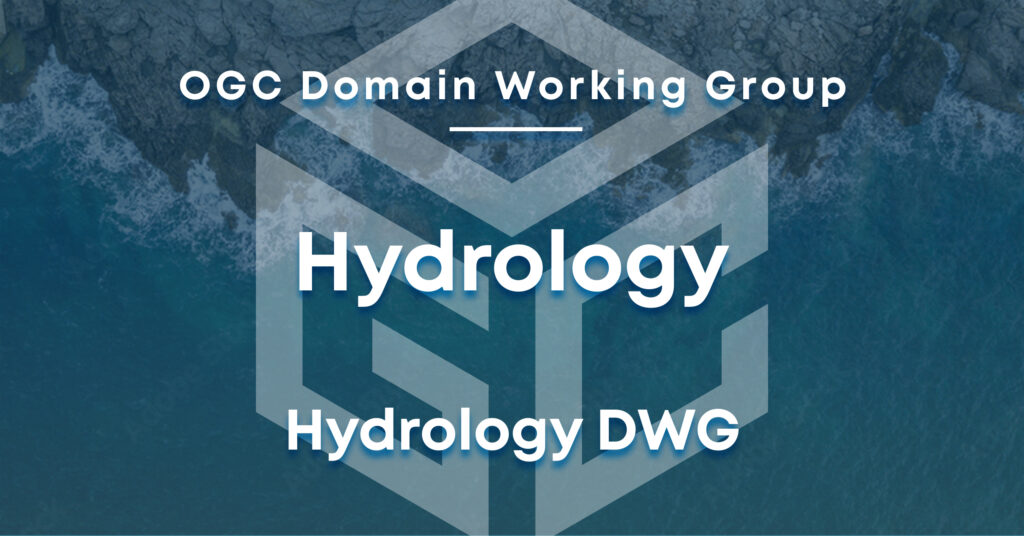OGC announces Christy Monaco as new Chief Operating Officer
As OGC’s COO, Christy will use her experience with federal agencies, partnership-building, event management, and member success to help grow and shape the Consortium.

The Hydrology DWG provides a venue and mechanism for seeking technical and institutional solutions to the challenge of describing and exchanging data describing the state and location of water resources, both above and below the ground surface.
The project scope for the OGC Hydrology Domain Working Group (DWG) is to address the global challenges associated with water resources. The primary objectives include drawing industry focus to the critical issues surrounding water resources, which are of increasing concern given the current trends in climate change, population growth, and industrial demands. To this end, the DWG is committed to fostering the development of technical solutions that promote interoperability through consistent concepts, data definitions, formats, and services. These solutions are geared towards enhancing the capabilities for publishing, searching, and exchanging water-related information across various platforms and stakeholders.
The group aims to identify and engage with a strategic set of partners to collaborate on demonstration projects. These projects are designed not only to develop but also to showcase the best practices in hydrologic information management. By doing so, the DWG seeks to set precedents that can be adopted widely to improve water information systems. A critical aspect of the DWG’s scope is to establish and maintain a pragmatic approach to the standardization of hydrologic spatial features, their temporal characteristics, associated metadata, and other vital business information. This approach is intended to streamline the management and dissemination of hydrologic information, thus facilitating informed decision-making and sustainable water resource management.
The imperative for the Hydrology DWG has been underscored by the recent and ongoing water crises impacting the globe. These crises reveal a concerning gap in our capability to adequately characterize water resources and hydrological hazards, and to disseminate this critical information effectively. The escalating demands placed on water resources due to population growth, climate change, and various other factors underscore the scarcity of this vital resource. In response to these challenges, agencies worldwide are being established with the mandate to gather and manage water data, leveraging an influx of information from in-situ and remote sensing technologies. Enhanced telecommunication and computing capacities now allow for near-real-time analysis of water resources, resulting in an unprecedented availability of water data.
However, the vast amount of water information available lacks a standardized, consensus-based set of definitions or interoperable formats for its organization and exchange. The challenge is twofold: firstly, there is a need for a consistent framework of formalisms that encapsulate essential hydrological concepts such as watersheds, estuaries, and river channels, as well as typical methodologies for hydrological data organization like time series analysis. Secondly, it’s essential that these formalisms are articulated using a general and coherent notation to ensure that hydrological data is unambiguously understood and can be seamlessly integrated with data from related fields. The DWG’s role is pivotal in developing these standards to improve the interoperability and utility of hydrological information, facilitating better management and response to the growing global water challenges.
The activities of the DWG are designed to address the complexities of hydrologic data management and exchange. To this end, the DWG commits to the creation and dissemination of communications materials that delve into the technical aspects of this issue. These materials include white papers, an accessible and informative website hosted within the OGCNetwork, and other relevant documents that illuminate the challenges and solutions in hydrologic data management.
Further, the DWG maintains and moderates a mailing list dedicated to discussions pertinent to hydrologic issues within the OGC community, fostering a platform for knowledge exchange and debate. Relationship building is another cornerstone of the DWG’s activities, where it actively seeks to unite members from both the geospatial and hydrological communities to facilitate and nurture communication and collaboration. This involves orchestrating and executing demonstration, pilot, and production projects that not only exhibit but also test technical methods of managing and exchanging hydrological data, integrating OGC technologies with emerging solutions from the hydrological sphere.
The DWG also serves as an incubator for the development of specification profiles and application schemas specifically tailored for hydrological applications. This role extends to engaging potential sponsors and stirring their interest in supporting the diverse set of activities that the DWG undertakes. By attracting sponsorship, the DWG ensures the continuity and expansion of its initiatives, contributing to the evolution of hydrological data management practices.
The DWG is hosted by the OGC and co-chaired by up to two representatives nominated by the World Meteorological Organisation’s (WMO) Commission for Hydrology (CHy) from their Open Panel of CHy Experts (OPACHE). The Hydrology Domain Working Group will also coordinate efforts with other OGC earth science DWGs and liaise with external Standards Development Organizations such as ISO.
Working Group Chairs: Dave Blodgett (US Geological Survey), Tony Boston (World Meteorological Organization), Silvano Pecora (World Meteorological Organization)
Receive the latest news on OGC.
© 2024 Open Geospatial Consortium. All Rights Reserved.